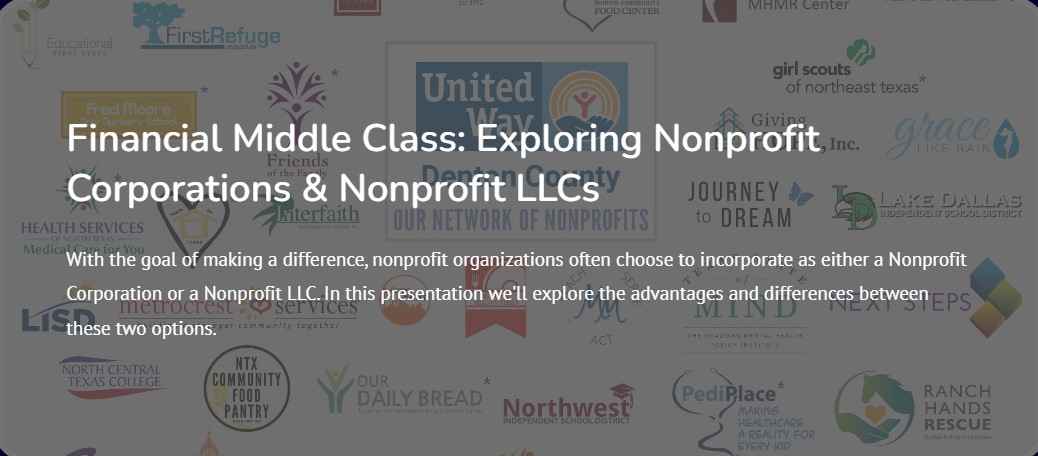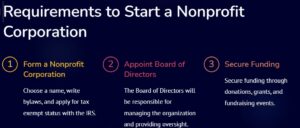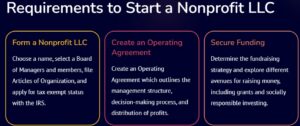
Nonprofit Corporations vs. Nonprofit LLCs
By MacKenzy Pierre
The estimated reading time for this post is 251 seconds
Nonprofit Corporation vs. Nonprofit LLC: Understanding the Advantages and Differences
United Way Worldwide, Feeding America, and the American Red Cross are among the largest nonprofit organizations in the United States. They are crucial in addressing social issues, championing charitable causes, and positively impacting communities worldwide.
Although their governance is to impact communities rather than enhance shareholders’ wealth, nonprofit organizations still have to be established and structured legally. Nonprofit Corporations and LLCs have legal recognition and protection to fulfill their philanthropic missions.
This article explores the advantages and differences between incorporating as a nonprofit corporation and a nonprofit Limited Liability Company (LLC).
Understanding these options is crucial for nonprofit leaders, as their decisions will profoundly impact the organization’s ability to pursue its goals effectively and ethically.
Nonprofit Corporation: Empowering Vision through Formality

Nonprofit Corporation
Nonprofit corporations stand as time-tested social impact pillars, their purpose-driven ethos resonating deeply with countless missions worldwide. Their legal structure, governed by state laws, grants them several distinct advantages contributing to their popularity among nonprofit organizations.
Limited Liability: A nonprofit corporation’s most significant advantage is its limited liability to its directors, officers, and members.
This legal protection ensures that personal assets remain shielded from the financial and legal obligations incurred by the organization. As a result, individuals can fearlessly pursue their social goals, secure in the knowledge that their personal finances are not at stake.
Tax-Exempt Status: The allure of federal tax-exempt status, as granted under section 501(c)(3) of the Internal Revenue Code, beckons nonprofit corporations.
This designation bestows tax deductibility upon donations, motivating individuals and corporations to contribute to the cause. As fundraising success amplifies, nonprofits can further propel their mission and impact.
Permanence and Stability: Nonprofit corporations typically possess perpetual existence, transcending the involvement of founding members or key personnel. The permanence grants a sense of stability, ensuring the organization’s commitment to its goals endures across generations.
Governance Structure: A hallmark of nonprofit corporations is their formalized governance structure. Governed by a board of directors, these organizations uphold transparency, accountability, and compliance with the mission, enhancing public trust and credibility.
Forming a Nonprofit Organization
Forming a nonprofit organization requires the same steps as starting other corporations:
- Select a name for the corporation
- Submit Articles of Incorporation to the Secretary of State (or other agency)
- Make corporate bylaws
- Apply for tax-exempt status
Nonprofit LLC: Pioneering New Avenues of Social Good

Nonprofit LLC
The emergence of nonprofit LLCs recently brought forth a fresh perspective on blending mission-driven objectives with a flexible operational approach. Although unavailable in all states, nonprofit LLCs offer unique attributes that appeal to specific nonprofit organizations.
Limited Liability: Similar to their nonprofit corporation counterparts, nonprofit LLCs prioritize limited liability protection for their members. This safeguard ensures that personal assets remain inviolable, empowering members to pursue innovative strategies without excessive fear of financial repercussions.
Operational Flexibility: The allure of a nonprofit LLC lies in its operational agility and adaptability. These entities can engage in more diverse activities, spanning charitable and business-oriented endeavors. Such flexibility benefits organizations seeking diverse revenue streams or venturing into social enterprises.
No Federal Tax-Exempt Status: Unlike nonprofit corporations, nonprofit LLCs do not automatically qualify for federal tax-exempt status under section 501(c)(3). Nonetheless, depending on the jurisdiction, they may still be eligible for certain state tax exemptions.
Member-Managed Structure: The informal and member-managed structure of nonprofit LLCs empowers individuals with a heightened sense of control and autonomy. This participatory approach fosters a dynamic environment, stimulating creativity and collaboration.
Differences Between Nonprofit Corporations and Nonprofit LLCs: Paving the Path to Purpose
To discern the most suitable path, nonprofit leaders must weigh the disparities between nonprofit corporations and nonprofit LLCs.
Tax Implications: The allure of federal tax-exempt status remains a hallmark of nonprofit corporations, enabling them to offer tax deductions to generous donors. Nonprofit LLCs, however, must rely on state-level tax exemptions, which may vary significantly in scope and magnitude.
Governance Structure: Nonprofit corporations embrace formalized governance, with a board of directors assuming the mantle of responsibility. Nonprofit LLCs, in contrast, offer a more flexible management approach driven by member involvement and input.
Permissible Activities: Nonprofit corporations must maintain their tax-exempt status by limiting their activities to charitable and nonprofit endeavors. Nonprofit LLCs, while adhering to social impact, can explore revenue-generating initiatives that align with their mission.
Conclusion
The choice between incorporating as a nonprofit corporation or a nonprofit LLC is pivotal for organizations dedicated to purposeful impact.
Nonprofit corporations, nestled in their formal structures, offer the allure of federal tax-exempt status and enduring stability. Conversely, nonprofit LLCs have new horizons with operational flexibility and member-driven engagement.
As nonprofit leaders embark on this momentous decision, it is essential to discern the alignment between the chosen legal structure and the organization’s unique mission.
By thoughtfully considering the advantages and differences presented, nonprofit organizations can blaze their path to purposeful impact, transforming lives and empowering communities on their journey to a brighter, more compassionate future.
Senior Accounting & Finance Professional|Lifehacker|Amateur Oenophile
RELATED ARTICLES
Florida’s Property-Tax Crossroads: What Voters Need to Know
Florida property tax changes explained. See how HJR 201–215 could affect you, your rent, and local services before you vote.
What the New Household Debt Report Means for the Middle Class
Household debt just hit $18.6T. See what the new Fed report means for your mortgage, cards, and cash—and how to protect your balance sheet.
Leave Comment
Cancel reply
Gig Economy
American Middle Class / Dec 06, 2025
Spend Your FSA Before It Disappears: FSA vs HSA for Real Middle-Class Life
Don’t let your FSA money vanish. Learn the real difference between FSAs and HSAs and how to choose the right one for your middle-class budget.
By Article Posted by Staff Contributor
American Middle Class / Dec 06, 2025
Trump’s New $40,000 SALT Deduction Cap: Should Middle-Class Americans Care?
Will Trump’s higher $40,000 SALT cap actually help your middle-class family, or just coastal high earners? Learn what really changes for you.
By Article Posted by Staff Contributor
American Middle Class / Dec 04, 2025
Florida’s Property-Tax Crossroads: What Voters Need to Know
Florida property tax changes explained. See how HJR 201–215 could affect you, your rent, and local services before you vote.
By FMC Editorial Team
American Middle Class / Dec 04, 2025
Trailing Interest: The Credit Card Charge That Shows Up After You “Paid It Off”
Trailing interest can quietly cost you thousands in credit card charges—learn how to spot it, stop it, and keep more money in your pocket.
By Article Posted by Staff Contributor
American Middle Class / Dec 03, 2025
Should You Refinance Your Auto Loan?
Paying too much for your car? Learn when refinancing your auto loan saves money and how to avoid costly refi traps.
By Article Posted by Staff Contributor
American Middle Class / Dec 03, 2025
How to Avoid Being Upside-Down on a Car Loan
Worried you owe more than your car is worth? Learn how to avoid an upside-down car loan and protect your middle-class budget.
By Article Posted by Staff Contributor
American Middle Class / Dec 03, 2025
The Real Cost of Your Car: Why That “Affordable” Payment Is Wrecking Middle-Class Budgets
Think you just have a car payment? Learn your true total car cost and how to keep it from wrecking your middle-class budget. Start fixing it...
By Article Posted by Staff Contributor
American Middle Class / Dec 03, 2025
The December Energy Bill: Heat, lights, and inflated utility bills—practical cuts that don’t kill the vibe.
Heat, lights, and higher rates: decode your December energy bill and make smart cuts that lower costs without killing the holiday vibe.
By Article Posted by Staff Contributor
American Middle Class / Dec 02, 2025
BNPL at the Holidays: Convenience Now, Confusion Later
Stacked holiday BNPL plans can wreck your cash flow and credit. Learn how to track them, set guardrails, and protect your future self.
By Article Posted by Staff Contributor
American Middle Class / Dec 02, 2025
Money & Mental Bandwidth: How Holiday Stress Fuels Bad Purchases
Holiday stress shrinks your mental bandwidth. Spot emotional spending traps and use a simple decision tree to buy with intention, not guilt.
By Article Posted by Staff Contributor
Latest Reviews
American Middle Class / Dec 06, 2025
Spend Your FSA Before It Disappears: FSA vs HSA for Real Middle-Class Life
Don’t let your FSA money vanish. Learn the real difference between FSAs and HSAs and...
American Middle Class / Dec 06, 2025
Trump’s New $40,000 SALT Deduction Cap: Should Middle-Class Americans Care?
Will Trump’s higher $40,000 SALT cap actually help your middle-class family, or just coastal high...
American Middle Class / Dec 04, 2025
Florida’s Property-Tax Crossroads: What Voters Need to Know
Florida property tax changes explained. See how HJR 201–215 could affect you, your rent, and...